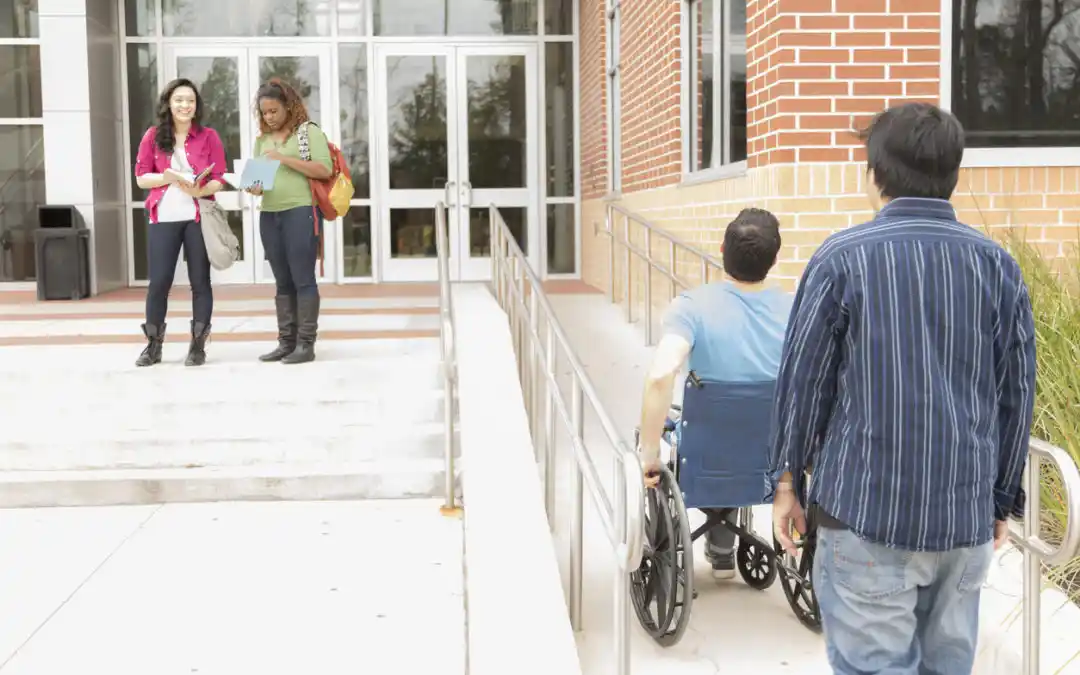Urban spaces must prioritize safety and inclusivity for older adults. One crucial element in achieving this is the installation of ADA-compliant ramps. These ramps not only grant access to individuals with mobility challenges but also enhance overall safety and convenience for older adults.
In this article, we will delve into the importance of selecting ADA-compliant ramps and their role in creating safe urban spaces for older adults. We will explore the specific features and requirements of these ramps, as well as the benefits they offer to individuals with disabilities and the wider community.
By prioritizing accessibility and inclusivity, urban planners and policymakers can ensure that our cities are welcoming and accommodating to all. Urban planners and policymakers play a crucial role in prioritizing accessibility to make cities welcoming for everyone. One significant step in achieving this goal is the careful choosing ADA compliant ramps. These ramps adhere to the guidelines set by the Americans with Disabilities Act (ADA), ensuring that they meet specific standards to accommodate individuals with disabilities.
Key Takeaways
- ADA compliance ensures equal access and safety for individuals with disabilities in public facilities through the use of ramps.
- Factors to consider when choosing ADA compliant ramps include the slope, slip-resistant surface, width, and installation of handrails.
- Different types of ADA compliant ramps are available, including threshold ramps, modular ramps, portable ramps, and ramp systems that meet all regulations.
- Proper installation, regular maintenance, and keeping the ramp clear of obstacles are important for the safety and usability of ADA compliant ramps.
Importance of ADA Compliance
Ensuring ADA compliance is of utmost importance when it comes to the installation of ramps in urban spaces. ADA, or the Americans with Disabilities Act, sets standards for accessibility to ensure that individuals with disabilities have equal access to public facilities.
When it comes to ramps, ADA compliance means adhering to specific guidelines regarding slope, width, handrails, and surface texture. These guidelines are in place to ensure the safety and usability of ramps for individuals with mobility impairments, including older adults.
By following ADA standards, ramps can accommodate individuals who use wheelchairs, walkers, or have difficulty navigating stairs.
ADA-compliant ramps not only promote inclusivity but also reduce the risk of accidents and injuries.
Therefore, it is crucial for urban spaces to prioritize ADA compliance when installing ramps to ensure the safety and accessibility of all individuals.
Factors to Consider When Choosing ADA Compliant Ramps
When selecting ADA compliant ramps, it is essential to consider various factors to ensure safety and accessibility for individuals with disabilities. One crucial factor to consider is the slope of the ramp. The ADA guidelines specify that ramps should have a maximum slope of 1:12, which means that for every inch of rise, there should be 12 inches of ramp length. This slope ensures that individuals with mobility impairments can navigate the ramp safely and comfortably.
Additionally, the ramp surface should be slip-resistant to prevent accidents, especially in wet or icy conditions.
Another factor to consider is the width of the ramp. ADA guidelines recommend a minimum width of 36 inches to accommodate individuals using mobility devices such as wheelchairs or walkers.
Finally, handrails should be installed on both sides of the ramp to provide support and stability.
Considering these factors is crucial for creating inclusive and accessible spaces for individuals with disabilities.

Types of ADA Compliant Ramps Available
There are several types of ADA compliant ramps available that offer safe and accessible solutions for individuals with disabilities. These ramps are designed to meet the specific requirements outlined in the Americans with Disabilities Act (ADA) and provide equal access to public spaces.
Here are four types of ADA compliant ramps:
- Threshold ramps: These ramps are used to bridge small height differences, such as door thresholds or curbs. They are lightweight and portable, making them easy to install and remove as needed.
- Modular ramps: These ramps are made up of interchangeable sections that can be configured to fit various inclines and lengths. They are often used for permanent installations and can be customized to meet specific accessibility needs.
- Portable ramps: These ramps are lightweight and foldable, making them easy to transport and store. They are ideal for temporary access needs, such as at events or when visiting a location that is not ADA compliant.
- ADA compliant ramp systems: These ramps are designed to meet all ADA regulations, including slope, width, handrail height, and landing requirements. They are often made from durable materials like aluminum and provide a permanent, reliable solution for accessibility.
Installation and Maintenance of ADA Compliant Ramps
To ensure the proper installation and maintenance of ADA compliant ramps, it is essential to follow specific guidelines and procedures. The installation process begins with selecting the appropriate location for the ramp, considering factors such as slope, width, and landing space. The ramp should have a gentle slope of no more than 1:12, meaning for every inch of vertical rise, there should be 12 inches of horizontal run. This ensures a gradual incline that is safe for individuals with mobility challenges. Additionally, the ramp should be wide enough to accommodate wheelchairs and walkers, with a minimum width of 36 inches. Handrails should be installed on both sides, providing support and stability.
Maintenance of ADA compliant ramps is crucial to ensure their longevity and functionality. Regular inspections should be conducted to identify any damage or deterioration, such as cracks, loose handrails, or uneven surfaces. These issues should be promptly addressed and repaired to prevent accidents and maintain the ramp’s accessibility. Additionally, snow and ice should be promptly removed during winter months to prevent slippery conditions. It is also important to keep the ramp clear of any obstacles, ensuring a safe and obstruction-free passage.
Benefits of Using ADA Compliant Ramps for Older Adults
The utilization of ADA compliant ramps provides numerous benefits for older adults, ensuring safe and accessible passage throughout urban spaces.
- Safety: ADA compliant ramps are designed with safety in mind, reducing the risk of slips, trips, and falls for older adults. The ramps are constructed with non-slip surfaces and handrails for stability, providing a secure pathway.
- Independence: By having ADA compliant ramps in place, older adults can maintain their independence and mobility. They can easily navigate through different areas without relying on assistance from others, promoting a sense of autonomy and dignity.
- Accessibility: ADA compliant ramps make urban spaces more accessible for older adults, allowing them to participate fully in community activities. This inclusivity fosters a sense of belonging and social engagement, combating feelings of isolation.
- Health and well-being: By providing accessible ramps, older adults are encouraged to engage in physical activity, promoting better overall health and well-being. The ramps enable them to remain active and continue enjoying outdoor spaces, contributing to their physical and mental well-being.
Frequently Asked Questions
Can Ada-Compliant Ramps Be Used in Residential Settings as Well?
Yes, ADA-compliant ramps can be used in residential settings as well. These ramps provide accessibility and safety for older adults in urban spaces, ensuring they can navigate their surroundings comfortably and independently.
Are There Any Specific Weight Limits for Ada-Compliant Ramps?
ADA-compliant ramps typically have weight limits specified by the manufacturer or local building codes. These limits ensure the safety and structural integrity of the ramp. It is important to consult relevant guidelines and regulations to determine specific weight limits for ADA-compliant ramps.
Are There Any Regulations Regarding the Slope of Ada-Compliant Ramps?
Yes, there are regulations regarding the slope of ADA-compliant ramps. According to the ADA Accessibility Guidelines, the maximum slope allowed for a ramp is 1:12, meaning that for every 12 inches of horizontal distance, the ramp must rise no more than 1 inch.
Can Ada-Compliant Ramps Be Customized to Fit Specific Spaces and Requirements?
Yes, ADA-compliant ramps can be customized to fit specific spaces and requirements. This flexibility allows for the creation of safe and accessible environments for older adults, ensuring their mobility and independence in urban spaces.
Is It Necessary to Hire a Professional for the Installation of Ada-Compliant Ramps?
Yes, it is necessary to hire a professional for the installation of ADA-compliant ramps. Professionals possess the expertise and knowledge required to ensure that the ramps are installed correctly and meet all necessary safety and accessibility standards.
Conclusion
In conclusion, ADA-compliant ramps play a vital role in creating safe and inclusive urban spaces for older adults. By ensuring accessibility and meeting the standards set by the Americans with Disabilities Act, these ramps provide individuals with mobility challenges the means to navigate public areas with ease.
Additionally, ADA-compliant ramps contribute to the overall safety and convenience of older adults, promoting their well-being in urban environments. It is essential for urban planners and policymakers to prioritize the installation and maintenance of these ramps to foster accessibility and inclusivity in our cities.
You may also like to read:
How Chiropractic Care Boosts Athletic Performance









